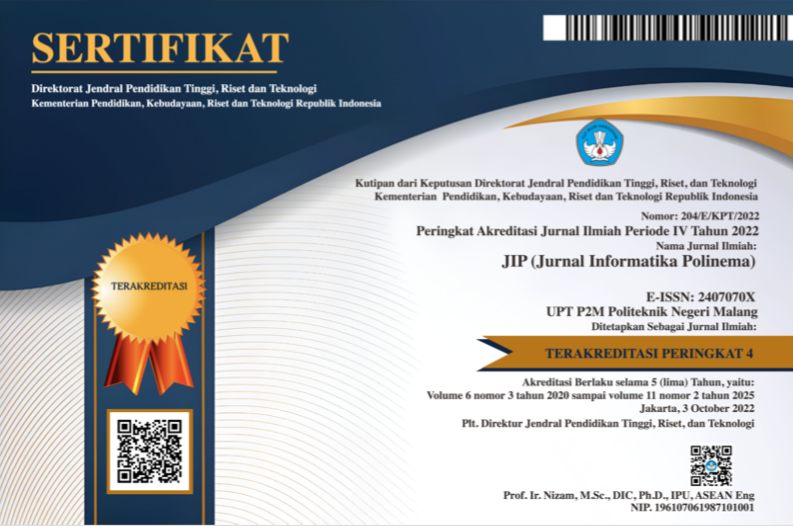METODE PENILAIAN KEKUATAN GEMPA MENGGUNAKAN MODEL FEATURE SELECTION M5-PRIME DAN LINEAR REGRESSION
Abstract
Pemetaan suatu wilayah khususnya daerah rawan bencana bagi pemangku kepentingan sangat penting sekali karena ha ini akan memberikan pengaruh terhadap kebijakan yang nanatinya akan ditetapkan terlebih dalam upaya penanggulangan bencana alam gempa bumi. Memprediksi kekuatan gempa menjadi permasalahan yang sampai saat ini belum dapat dipastikan dan yang bisa dilakukan adalah sebatas memprediksi dari dari kejadian-kejadian sebelumnya. Algoritma linear regression diterapkan dan diusulkan untuk digunakan sebagai model prediksi gempa, selain itu diusulkan pula feature selection dengan menggunakan algoritma M5-Prime sebagai upaya dalam peningkatan akurasi prediksi. Hasil penelitian memperlihatkan algoritma liner regression berbasis feature selection M5-Prime mampu dijadikan sebagai model prediksi gempa dengan nilai RMSE terbaik sebesar 0,707.
Downloads
References
Benjamin, K., & Konstantinos, F. (2002). Regression Models for Time Series Analysis. Wiley.
Ćalasan, M., Abdel Aleem, S. H. E., & Zobaa, A. F. (2020). On the root mean square error (RMSE) calculation for parameter estimation of photovoltaic models: A novel exact analytical solution based on Lambert W function. Energy Conversion and Management, 210, 112716. https://doi.org/10.1016/j.enconman.2020.112716
Chai, T., & Draxler, R. R. (2014). Root mean square error (RMSE) or mean absolute error (MAE)? – Arguments against avoiding RMSE in the literature. Geoscientific Model Development, 7(3), 1247–1250. https://doi.org/10.5194/gmd-7-1247-2014
Chicco, D., Warrens, M. J., & Jurman, G. (2021). The coefficient of determination R-squared is more informative than SMAPE, MAE, MAPE, MSE and RMSE in regression analysis evaluation. PeerJ Computer Science, 7, e623. https://doi.org/10.7717/peerj-cs.623
Draper, N. R., & Harry, S. (2014). Applied Regression Analysis, 3rd Edition. John Willey & Sons, Inc.
Ewusie, J. E., Soobiah, C., Blondal, E., Beyene, J., Thabane, L., & Hamid, J. S. (2020). Methods, Applications and Challenges in the Analysis of Interrupted Time Series Data: A Scoping Review. Journal of Multidisciplinary Healthcare, Volume 13, 411–423. https://doi.org/10.2147/JMDH.S241085
Jung, D., & Choi, Y. (2021). Systematic Review of Machine Learning Applications in Mining: Exploration, Exploitation, and Reclamation. Minerals, 11(2), 148. https://doi.org/10.3390/min11020148
Khotimah, B. K., & Sari Rochman, E. M. (2021). MODEL PERAMALAN JUMLAH PENYAKIT DEMAM BERDARAH DENGAN PENDEKATAN METODE FUZZY LINEAR REGRESSION (FLR). Network Engineering Research Operation, 6(1), 49. https://doi.org/10.21107/nero.v6i1.215
Laerd Statistics. (n.d.). Linear Regression Analysis using SPSS Statistics. Retrieved April 1, 2022, from https://statistics.laerd.com
Mandayam, A. U., A.C, R., Siddesha, S., & Niranjan, S. K. (2020). Prediction of Covid-19 pandemic based on Regression. 2020 Fifth International Conference on Research in Computational Intelligence and Communication Networks (ICRCICN), 1–5. https://doi.org/10.1109/ICRCICN50933.2020.9296175
Muhamad Iqbal, R., & Prihandoko, P. (2017). PENERAPAN DATA MINING UNTUK ANALISIS DATA BENCANA MILIK BNPB MENGGUNAKAN ALGORITMA K-MEANS DAN LINEAR REGRESSION. Jurnal Ilmiah Informatika Komputer, 22(1). https://ejournal.gunadarma.ac.id/index.php/infokom/article/view/1535
Nastiti, M. D., Abdurohman, M., & Putrada, A. G. (2019). Smart Shopping Prediction on Smart Shopping With Linear Regression Method. 2019 7th International Conference on Information and Communication Technology (ICoICT), 1–6. https://doi.org/10.1109/ICoICT.2019.8835271
Permai, S. D., & Tanty, H. (2018). Linear regression model using bayesian approach for energy performance of residential building. Procedia Computer Science, 135, 671–677. https://doi.org/10.1016/j.procs.2018.08.219
Shaikh, S., Gala, J., Jain, A., Advani, S., Jaidhara, S., & Roja Edinburgh, M. (2021). Analysis and Prediction of COVID-19 using Regression Models and Time Series Forecasting. 2021 11th International Conference on Cloud Computing, Data Science & Engineering (Confluence), 989–995. https://doi.org/10.1109/Confluence51648.2021.9377137
Somantri, O. (2021). PREDIKSI KEKUATAN GEMPA BUMI INDONESIA BERDASARKAN NILAI MAGNITUDO MENGGUNAKAN NEURAL NETWORK. Prosiding Seminar Nasional Informatika Bela Negara, 2, 203–207. https://doi.org/10.33005/santika.v2i0.124
Somantri, O., Purwaningrum, S., & Riyanto, R. (2022). MODEL SUPPORT VEKTOR MACHINE (SVM) BERDASARKAN PARAMETER WINDOWS UNTUK PREDIKSI KEKUATAN GEMPA BUMI. JTT (Jurnal Teknologi Terapan), 8(1), 17–24. https://doi.org/10.31884/JTT.V8I1.352
Sugiyarto, I., Irawan, R., & Rosiyadi, D. (2021). Pengelompokan Dampak Gempa Bumi Dan Kerusakan Pada Wilayah Berpotensi Gempa Di Provinsi Sumatra Barat. Journal of Students‘ Research in Computer Science, 2(2), 211–222. https://doi.org/10.31599/jsrcs.v2i2.850
Yijun, X., & Zhang, Y. (2012). Analysis and prediction of the total number of ice-snow tourism in Heilongjiang based on times series: A case study of Harbin. 2012 IEEE Symposium on Robotics and Applications (ISRA), 624–626. https://doi.org/10.1109/ISRA.2012.6219266
YILDIZ, H., & YANDI, A. (2021). Comparison of M5-Prime and Linear Regression Methods in Various Relationship Types between Variables. İnönü Üniversitesi Eğitim Fakültesi Dergisi, 22(1), 744–771. https://doi.org/10.17679/inuefd.758378
Copyright (c) 2022 Oman Somantri, Ratih Hafsarah Maharrani

This work is licensed under a Creative Commons Attribution-NonCommercial 4.0 International License.
Copyright for articles published in this journal is retained by the authors, with first publication rights granted to the journal. By virtue of their appearance in this open access journal, articles are free to use after initial publication under the International Creative Commons Attribution-NonCommercial 4.0 Creative Commons CC_BY_NC.
















